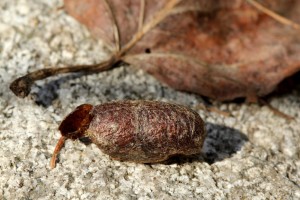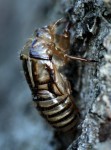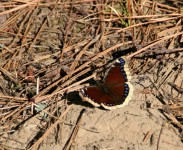Butterflies, moths, beetles, flies and bees all look different when they are young. From caterpillars to grubs and maggots, these young undergo a major transformation to become adults–complete metamorphosis.

Cocoons usually contain silk but some are made of foreign material with little or no silk. Some hairy caterpillars even incorporate body hairs into their cocoons.
Last week, I wrote about incomplete metamorphosis and how the young and adults look similar but the young are smaller and lack wings. Insects that undergo complete metamorphosis look completely different when they are young.
As with incomplete metamorphosis, complete metamorphosis begins when the insect is an egg. However, instead of three stages there are four: egg, larva, pupa and adult.
The egg hatches into a larva that is typically a soft worm-like creature. The main purpose of the larva is to eat. Caterpillars may grow more than 100 times their initial size during the larval stage. For example, the monarch caterpillar when hatched is not much bigger than a pinhead but it grows up to two inches long in several weeks.
Like larvae that undergo incomplete metamorphosis, the larvae that undergo complete metamorphosis also molt their skins as they grow except they may be soft skins.
Once the larva is finished eating, it begins the pupa stage where major transitions occur. Unlike incomplete metamorphosis, the insect actually rests (at least in the physical sense) during the pupal stage.
Butterflies spin a chrysalis, moths and other insects create cocoons, and others create pupal chambers. The pupal stage can last a few weeks to years.
What exactly happens inside a chrysalis or moth cocoon?
With the help of modern technology, scientists discovered that caterpillars release enzymes that digest their tissues and turn the caterpillar into “chunky soup”. Still intact are some organs, clumps of cells and imaginal discs.
Imaginal discs are highly organized groups of cells that developed when the caterpillar was in the egg stage. Each imaginal disc is the starting point for an adult body part like eyes, wings, legs, etc.
Depending on the species, the imaginal discs remain dormant until the pupal stage or they begin forming the specific body part during the caterpillar stage. The body parts are within the caterpillar so we cannot see them.
During the pupal stage, the imaginal discs utilize the protein-rich “soup” surrounding them to fuel rapid cell division and create their designated body part.
One of the few body parts that isn’t massively reorganized is the tracheal tubes. They become bigger during the pupal stage but the arrangement barely changes.
When the adult form is attained, the adult prepares to emerge. When the polyphemus moth is ready to emerge from its cocoon, it secretes a fluid to dissolve the gummy substance it used to bind its silk cocoon together. Then the moth can push the silk fibers aside and work its way out.
For the majority of insects, the purpose of the adult stage is to reproduce and disperse. Some adult species eat while others do not causing some to only live one to two weeks and others to live for several months.
We recognize most insects in their adult form since they usually have wings to move around. Those insects have come a long ways from the caterpillar, grub or maggot they began life as out of an egg.




